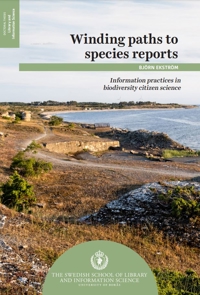Information practices in citizen science under the microscope in new thesis
2024-10-21

Ever since the days of Carl Linnaeus, the public has been engaged in environmental science research. With the help of nets, binoculars, and paper and pencil, people have gone out into nature to experience – and document – flora and fauna. Citizen science is a relatively new term for this established phenomenon; the animal and nature enthusiasts of the 2020s have supplemented their notebooks with smartphone apps and a connection to digital information systems such as the central Swedish node Artportalen. At times, species observations end up being addressed in the public sphere, when environmental and economic interests are pitted against each other.
Competition can lead to bias
 “My studies show that citizen science contributes a large and significant amount of data. At the same time, participants compete to see who can spot the most or rarest species, which can lead to a bias in the scope of the data,” said Björn Ekström.
“My studies show that citizen science contributes a large and significant amount of data. At the same time, participants compete to see who can spot the most or rarest species, which can lead to a bias in the scope of the data,” said Björn Ekström.
Through interviews and participant observation during time spent in the field, Björn Ekström has investigated how people participate in voluntary nature monitoring. His focus has been on information practices in citizen science that have to do with biodiversity.
Another problem concerns the validation of species sightings and that not all metadata reach the reporting systems. Awareness of information practices can alleviate these problems. According to Björn Ekström, “Although the reports themselves are tidy and neat representations of identified sightings, the path to their creation is characterised by negotiations between people and material objects, with the species in the middle. There are winding paths to species reports.”
Accurate reports contribute to increased credibility
Every observed species reported in, for example, Artportalen, contributes to the greater picture of Sweden's flora and fauna.
“The ability to correctly report many, preferably rare, species adds to the credibility and authority of the participants, and the reports can be strengthened with, for example, photographs, or by sending samples to museums for validation,” said Björn Ekström.
His doctoral thesis discusses the quality versus quantity of data in citizen science and the importance of reporting metadata. This latter aspect refers to what methods are used. More transparency can help newcomers to learn approaches that are otherwise implicit or characterised by tacit knowledge.
In his studies, Björn Ekström also describes the participants' discussions about the lack of simple but functional tools for reporting in the field and suggests that the development of such tools can broaden data collection.
“Such tools can also help to guide new participants more easily into citizen science on biodiversity, as the threshold can be high,” said Björn Ekström.
Björn Ekström defended his thesis Winding Paths to Species Reports: Information Practices in Biodiversity Citizen Science on 11 October. He is also involved in a research project funded by Mistra Environmental Communication on information cultures, data, and environmental communication technology led by Professor Jutta Haider. Together with Professor Ola Pilerot, he is working on a book on practice theory in and for Library and Information Science.
Läs mer
Björn Ekström researcher profile page
More research in the area of Library and Information Science
Lina Färm. Translation by Eva Medin
Adobe Stock // Ida Danell (portrait photo of Björn Ekström)

